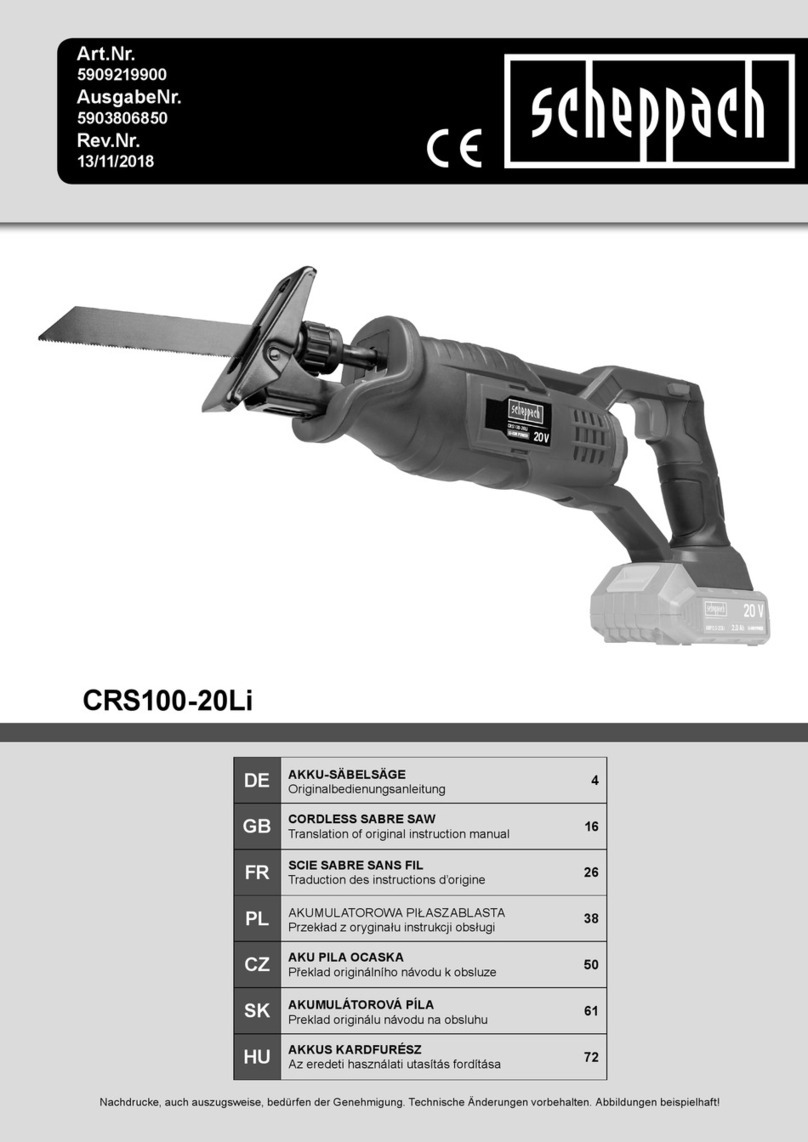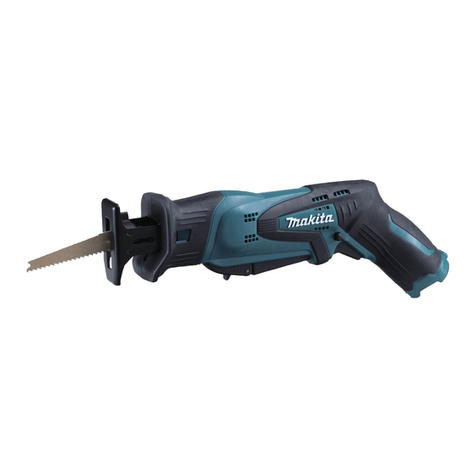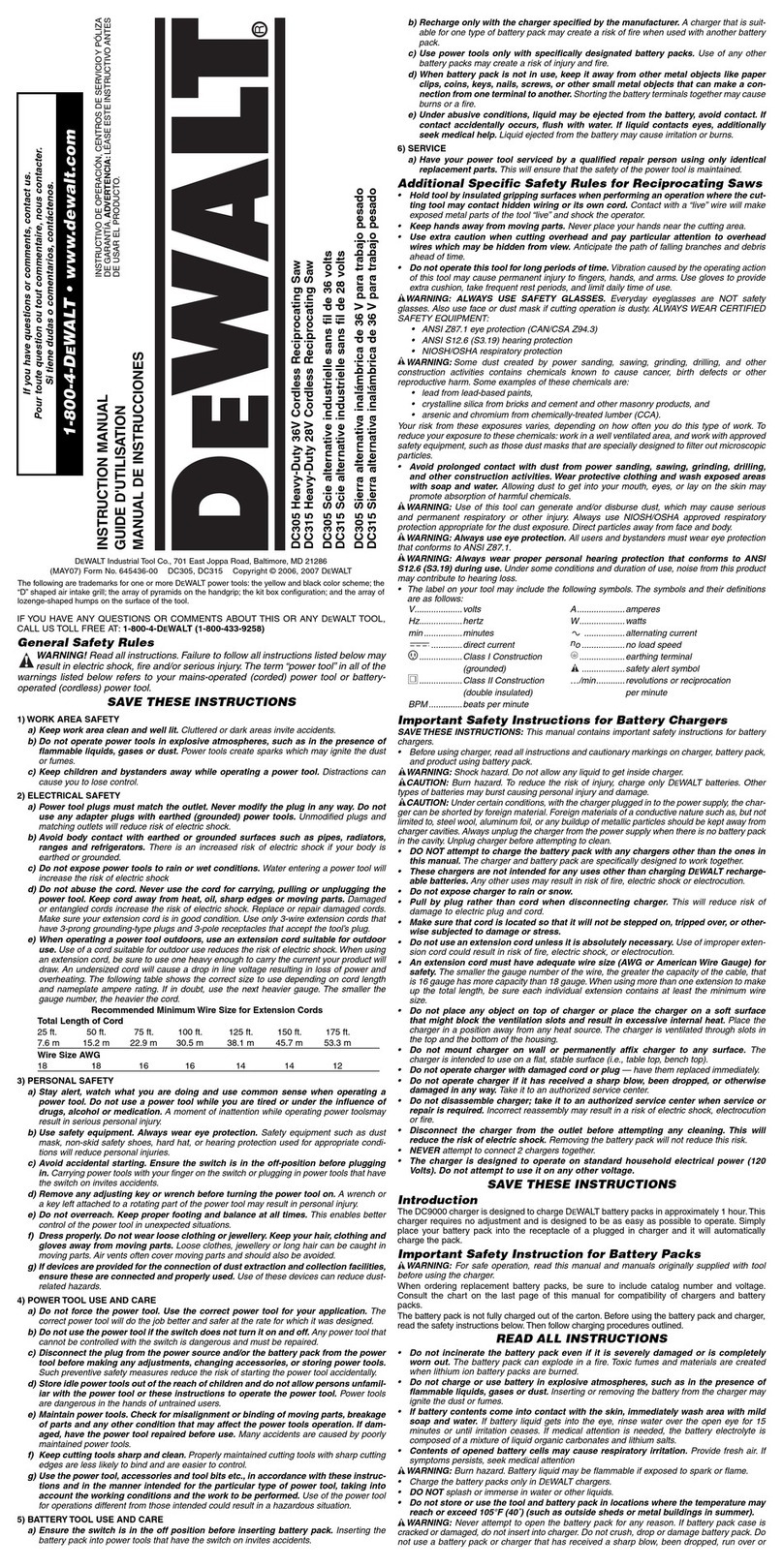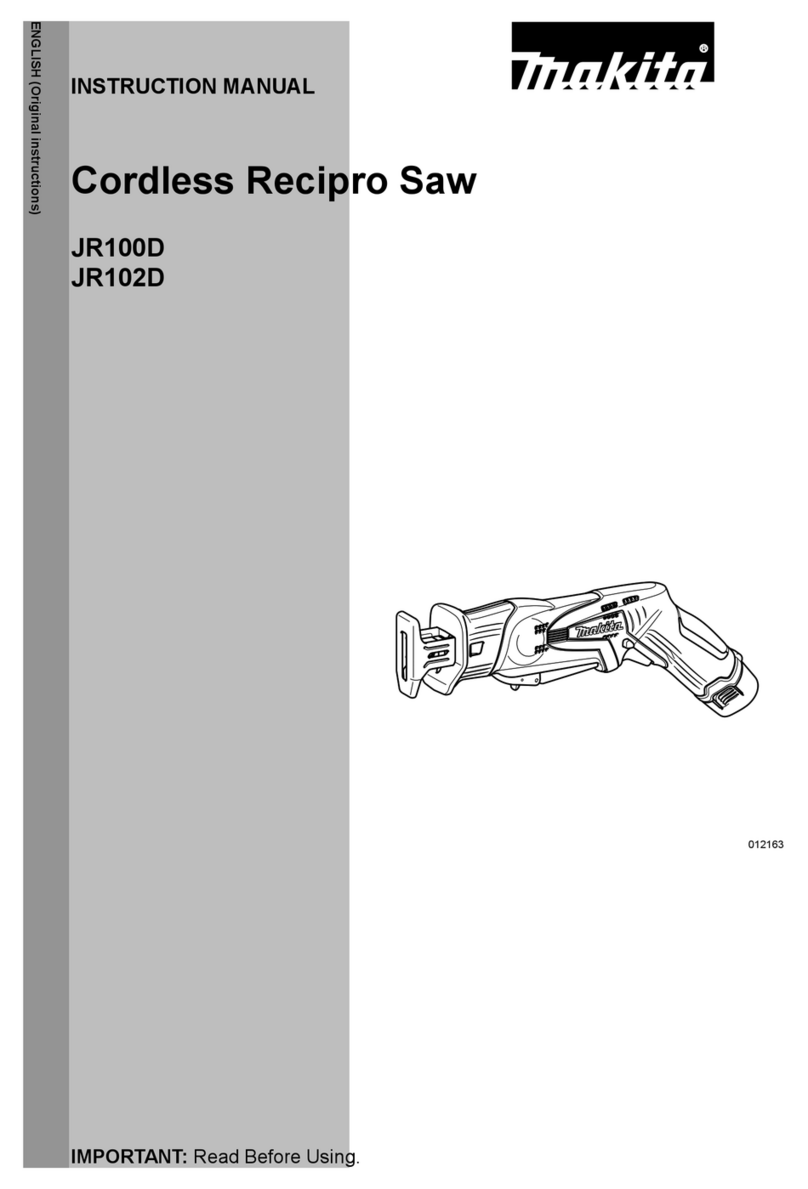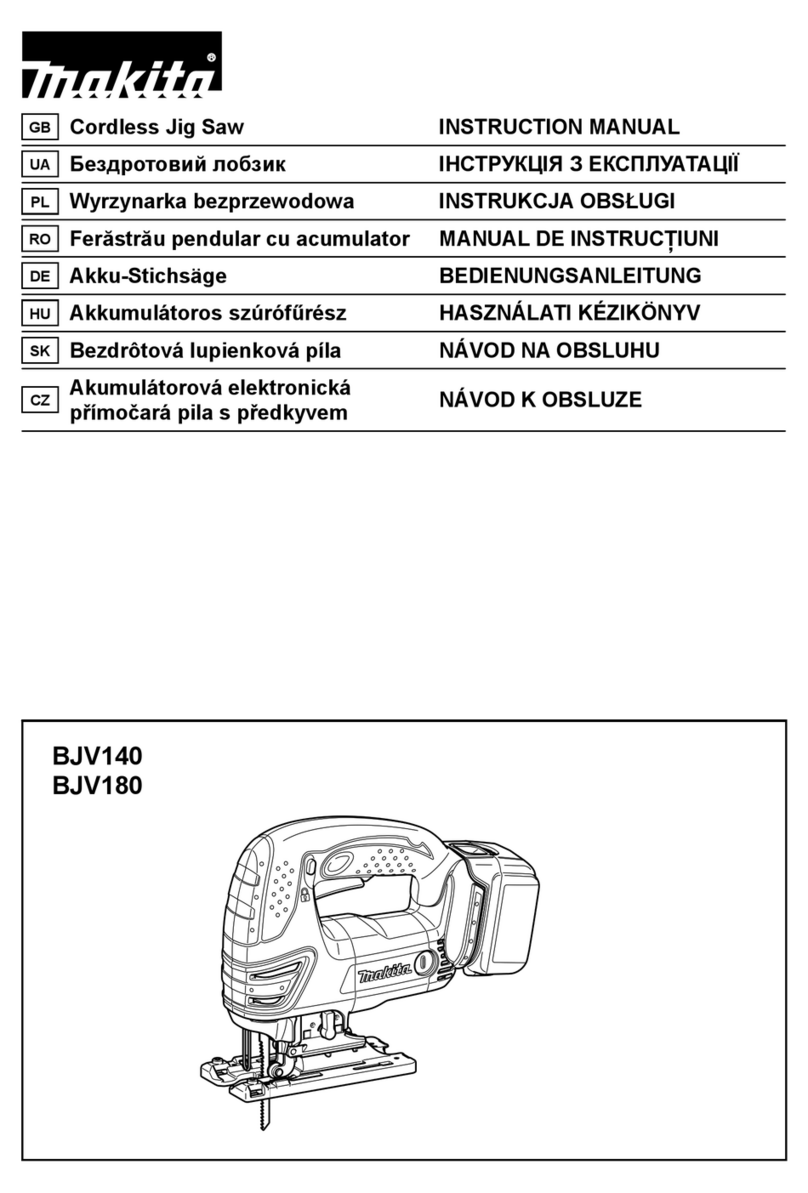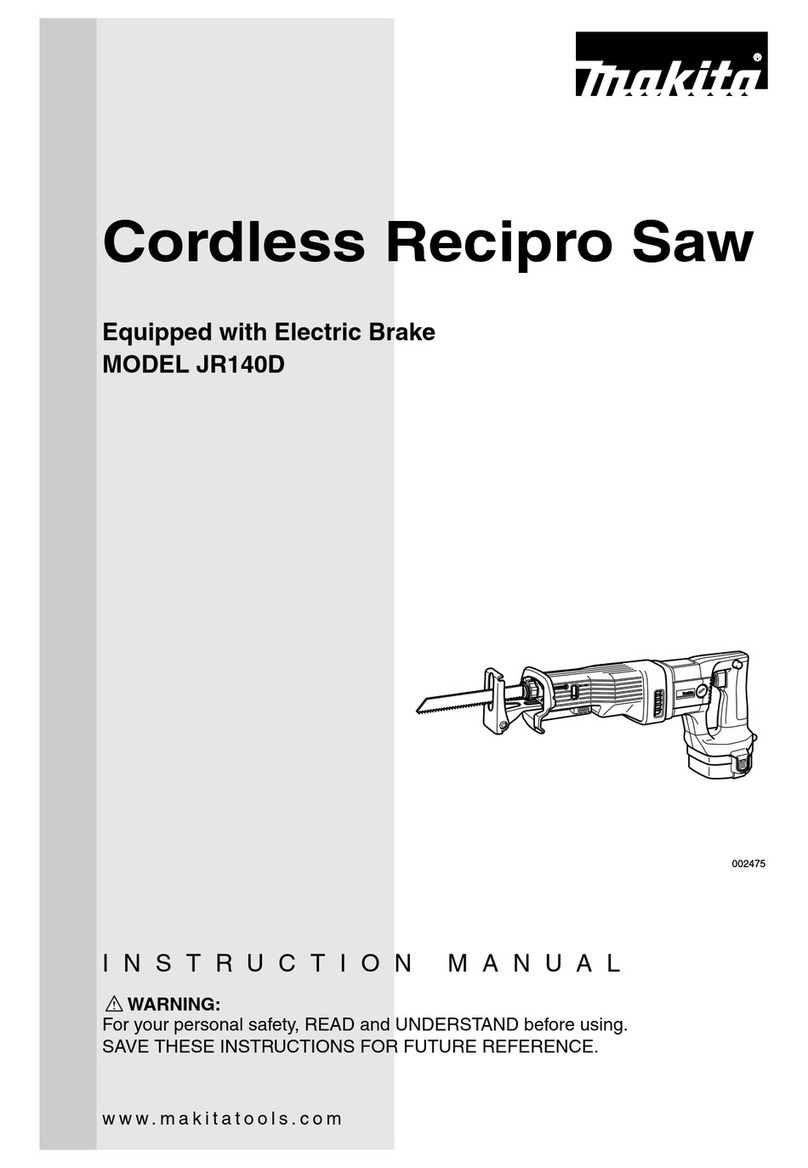DNA TOOLS-00173 User manual

1
INSTRUCTION MANUAL
Cordless Circular Saw
TOOLS-00173/00174
Power tool
EN

2
DESCRIPTION OF THE SYMBOLS
The use of symbols in this manual is intended to draw your attention to possible
risks. The safety symbols and the explanations that accompany them must be
perfectly understood. The warnings in themselves do not remove the risks and
cannot replace correct actions for preventing accidents.
This symbol, marking a point of safety, indicates a caution, warning or danger.
Ignoring this warning can result in an accident to yourself or others. To limit the risks
of injury, fire or electrocution, always follow the recommendations indicated.
WARNING –To reduce the risk of injury, user must read instruction manual.
Before any use, refer to the corresponding section in this user manual.
These symbols indicates the requirement of wearing ear protection, eye protection
and gloves when using the product.
The crossed-out wheeled bin symbol indicates that the item should be disposed of
separately from household waste. The item should be handed in for recycling in
accordance with local environmental regulations for waste disposal. By separating a
marked item from household waste, you will help reduce the volume of waste sent to
incinerators or land-fill and minimize any potential negative impact on human health
and the environment.

3
GENERAL POWER TOOL SAFETY WARNINGS
WARNING Read all safety warnings, instructions,
illustrations and specifications provided with this power
tool. Failure to follow all instructions listed below may result in electric
shock, fire and/or serious injury.
Save all warnings and instructions for future reference.
The term "power tool" in the warnings refers to your mains-operated (corded) power
tool or battery-operated (cordless) power tool.
1. Work area safety
a) Keep work area clean and well lit. Cluttered or dark areas invite accidents..
b) Do not operate power tools in explosive atmospheres, such as in the
presence of flammable liquids, gases or dust. Power tools create sparks
which may ignite the dust or fumes.
c) Keep children and bystanders away while operating a power tool.
Distractions can cause you to lose control.
2. Electrical safety
a) Power tool plugs must match the outlet. Never modify the plug in any
way. Do not use any adapter plugs with earthed (grounded) power tools.
Unmodified plugs and matching outlets will reduce risk of electric shock.
b) Avoid body contact with earthed or grounded surfaces, such as pipes,
radiators, ranges and refrigerators. There is an increased risk of electric
shock if your body is earthed or grounded.
c) Do not expose power tools to rain or wet conditions. Water entering a
power tool will increase the risk of electric shock.
d) Do not abuse the cord. Never use the cord for carrying, pulling or
unplugging the power tool. Keep cord away from heat, oil, sharp edges
or moving parts. Damaged or entangled cords increase the risk of electric
shock.
e) When operating a power tool outdoors, use an extension cord suitable
for outdoor use. Use of a cord suitable for outdoor use reduces the risk of
electric shock.
f) If operating a power tool in a damp location is unavoidable, use a
residual current device (RCD) protected supply. Use of an RCD reduces
the risk of electric shock.
NOTE: The term “residual current device (RCD)” can be replaced by the term
“ground fault circuit interrupter (GFCI)” or “earth leakage circuit breaker
(ELCB)”.
3. Personal safety
a) Stay alert, watch what you are doing and use common sense when
operating a power tool. Do not use a power tool while you are tired or
under the influence of drugs, alcohol or medication. A moment of
inattention while operating power tools may result in serious personal injury.
b) Use personal protective equipment. Always wear eye protection.
Protective equipment such as a dust mask, non-skid safety shoes, hard hat or
hearing protection used for appropriate conditions will reduce personal
injuries.
c) Prevent unintentional starting. Ensure the switch is in the off-position
before connecting to power source and/or battery pack, picking up or
carrying the tool. Carrying power tools with your finger on the switch or
energising power tools that have the switch on invites accidents.

4
d) Remove any adjusting key or wrench before turning the power tool on. A
wrench or a key left attached to a rotating part of the power tool may result in
personal injury.
e) Do not overreach. Keep proper footing and balance at all times. This
enables better control of the power tool in unexpected situations.
f) Dress properly. Do not wear loose clothing or jewellery. Keep your hair
and clothing away from moving parts. Loose clothes, jewellery or long hair
can be caught in moving parts.
g) If devices are provided for the connection of dust extraction and
collection facilities, ensure these are connected and properly used. Use
of dust collection can reduce dust-related hazards.
h) Do not let familiarity gained from frequent use of tools allow you to
become complacent and ignore tool safety principles. A careless action
can cause severe injury within a fraction of a second.
4. Power tool use and care
a) Do not force the power tool. Use the correct power tool for your
application. The correct power tool will do the job better and safer at the rate
for which it was designed.
b) Do not use the power tool if the switch does not turn it on and off. Any
power tool that cannot be controlled with the switch is dangerous and must be
repaired.
c) Disconnect the plug from the power source and/or remove the battery
pack, if detachable, from the power tool before making any adjustments,
changing accessories, or storing power tools. Such preventive safety
measures reduce the risk of starting the power tool accidentally.
d) Store idle power tools out of the reach of children and do not allow
persons unfamiliar with the power tool or these instructions to operate
the power tool. Power tools are dangerous in the hands of untrained users.
e) Maintain power tools and accessories. Check for misalignment or
binding of moving parts, breakage of parts and any other condition that
may affect the power tool’s operation. If damaged, have the power tool
repaired before use. Many accidents are caused by poorly maintained power
tools.
f) Keep cutting tools sharp and clean. Properly maintained cutting tools with
sharp cutting edges are less likely to bind and are easier to control.
g) Use the power tool, accessories and tool bits etc. in accordance with
these instructions, taking into account the working conditions and the
work to be performed. Use of the power tool for operations different from
those intended could result in a hazardous situation.
h) Keep handles and grasping surfaces dry, clean and free from oil and
grease. Slippery handles and grasping surfaces do not allow for safe handling
and control of the tool in unexpected situations.
5. Battery tool use and care
a) Recharge only with the charger specified by the manufacturer. A charger
that is suitable for one type of battery pack may create a risk of fire when used
with another battery pack.
b) Use power tools only with specifically designated battery packs. Use of
any other battery packs may create a risk of injury and fire.
c) When battery pack is not in use, keep it away from other metal objects,
like paper clips, coins, keys, nails, screws or other small metal objects,
that can make a connection from one terminal to another. Shorting the
battery terminals together may cause burns or a fire.
d) Under abusive conditions, liquid may be ejected from the battery; avoid
contact. If contact accidentally occurs, flush with water. If liquid contacts

5
eyes, additionally seek medical help. Liquid ejected from the battery may
cause irritation or burns.
e) Do not use a battery pack or tool that is damaged or modified. Damaged
or modified batteries may exhibit unpredictable behaviour resulting in fire,
explosion or risk of injury.
f) Do not expose a battery pack or tool to fire or excessive temperature.
Exposure to fire or temperature above 130 °C may cause explosion.
NOTE The temperature „130 °C“ can be replaced by the temperature „265
°F“.
g) Follow all charging instructions and do not charge the battery pack or
tool outside the temperature range specified in the instructions. Charging
improperly or at temperatures outside the specified range may damage the
battery and increase the risk of fire.
6. Service
a) Have your power tool serviced by a qualified repair person using only
identical replacement parts. This will ensure that the safety of the power tool
is maintained.
b) Never service damaged battery packs. Service of battery packs should only
be performed by the manufacturer or authorized service providers.
SPECIAL SAFETY INSTRUCTIONS
a) DANGER: Keep hands away from cutting area and the blade. Keep your
second hand on auxiliary handle, or motor housing. If both hands are
holding the saw, they cannot be cut by the blade.
b) Do not reach underneath the workpiece. The guard cannot protect you from
the blade below the workpiece.
c) Adjust the cutting depth to the thickness of the workpiece. Less than a full
tooth of the blade teeth should be visible below the workpiece.
d) Never hold piece being cut in your hands or across your leg. Secure the
workpiece to a stable platform. It is important to support the work properly to
minimize body exposure, blade binding, or loss of control.
e) Hold power tool by insulated gripping surfaces when performing an
operation where the cutting tool may contact hidden wiring or its own
cord. Contact with a "live" wire will also make exposed metal parts of the power
tool "live" and shock the operator.
f) When ripping always use a rip fence or straight edge guide. This improves
the accuracy of cut and reduces the chance of blade binding.
g) Always use blades with correct size and shape (diamond versus round) of
arbour holes. Blades that do not match the mounting hardware of the saw will
run eccentrically, causing loss of control.
h) Never use damaged or incorrect blade washers or bolt. The blade washers
and bolt were specially designed for your saw, for optimum performance and
safety of operation.
i) Causes and operator prevention of kickback:
kickback is a sudden reaction to a pinched, bound or misaligned saw blade,
causing an uncontrolled saw to lift up and out of the workpiece toward the
operator;
when the blade is pinched or bound tightly by the kerf closing down, the blade
stalls and the motor reaction drives the unit rapidly back toward the operator;
if the blade becomes twisted or misaligned in the cut, the teeth at the back edge
of the blade can dig into the top surface of the wood causing the blade to climb
out of the kerf and jump back toward the operator.
Kickback is the result of saw misuse and/or incorrect operating procedures or
conditions and can be avoided by taking proper precautions as given below.

6
j) Maintain a firm grip with both hands on the saw and position your arms to
resist kickback forces. Position your body to either side of the blade, but
not in line with the blade. Kickback could cause the saw to jump backwards,
but kickback forces can be controlled by the operator, if proper precautions are
taken.
k) When blade is binding, or when interrupting a cut for any reason, release
the trigger and hold the saw motionless in the material until the blade
comes to a complete stop. Never attempt to remove the saw from the
work or pull the saw backward while the blade is in motion or kickback
may occur. Investigate and take corrective actions to eliminate the cause of
blade binding.
l) When restarting a saw in the workpiece, centre the saw blade in the kerf
and check that saw teeth are not engaged into the material. If saw blade is
binding, it may walk up or kickback from the workpiece as the saw is restarted.
m) Support large panels to minimise the risk of blade pinching and kickback.
Large panels tend to sag under their own weight. Supports must be placed
under the panel on both sides, near the line of cut and near the edge of the
panel.
n) Do not use dull or damaged blades. Unsharpened or improperly set blades
produce narrow kerf causing excessive friction, blade binding and kickback.
Blade depth and bevel adjusting locking levers must be tight and secure
before making cut. If blade adjustment shifts while cutting, it may cause
binding and kickback.
o) Use extra caution when making a "plunge cut" into existing walls or other
blind areas. The protruding blade may cut objects that can cause kickback.
p) Check lower guard for proper closing before each use. Do not operate the
saw if lower guard does not move freely and close instantly. Never clamp
or tie the lower guard into the open position. If saw is accidentally dropped,
lower guard may be bent. Raise the lower guard with the retracting handle and
make sure it moves freely and does not touch the blade or any other part, in all
angles and depths of cut.
q) Check the operation of the lower guard spring. If the guard and the spring
are not operating properly, they must be serviced before use. Lower guard
may operate sluggishly due to damaged parts, gummy deposits, or a build-up of
debris.
r) Lower guard may be retracted manually only for special cuts such as
"plunge cuts" and "compound cuts." Raise lower guard by retracting
handle and as soon as blade enters the material, the lower guard must be
released. For all other sawing, the lower guard should operate automatically.
s) Always observe that the lower guard is covering the blade before placing
saw down on bench or floor. An unprotected, coasting blade will cause the
saw to walk backwards, cutting whatever is in its path. Be aware of the time it
takes for the blade to stop after switch is released.
WARNING
Some dust created by power sanding, sawing, grinding, drilling, and other
construction activities contains chemicals known to cause cancer, birth defects or
other reproductive harm. Some examples of these chemicals are:
- lead from lead-based paints,
- crystalline silica from bricks and cement and other masonry products, and
- arsenic and chromium from chemically-treated lumber.
Your risk from these exposures varies, depending on how often you do this type of
work. To reduce your exposure to these chemicals: work in a well ventilated area,

7
and work with approved safety equipment, such as those dust masks that are
specially designed to filter out microscopic particles.
The machine is intended for lengthways and crossways cutting of wood with straight cutting
lines as well as mitre cuts in wood while resting firmly on the workpiece. With suitable saw
blades, thin-walled non-ferrous metals, e. g., profiles, can also be sawed. Working ferrous
metals is not permitted
INTENDED USE
The machine is intended for lengthways and crossways cutting of wood with straight
cutting lines as well as mitre cuts in wood while resting firmly on the workpiece.
With suitable saw blades, thin-walled non-ferrous metals, e. g., profiles, can also be
sawed. Working ferrous metals is not permitted.
LIST OF MAIN PART
1. On/off switch
2. Lock-off switch
3. Battery capacity indicator
4. Lock knob of depth cut
5. Saw blade cover
6. Lock knob of mitre angle
7. Spindle lock
8. Hex key
TECHNICAL SPECIFIATIONS
Power
12 V
No-load speed
1450 min-1
Blade size
85mm
Max. Cutting depth
26 mm
Declaration of noise emission
LpA: 77,1 dB(A) K=3 dB(A)
LwA:88,1 dB(A) K=3 dB(A)
Vibration emission value
ah=3,368 m/s2 K=1,5 m/s2
NOISE/VIBRATION INFORMATION
Measured sound values determined according to EN 62841.
Wear hearing protection!
Vibration total values (triax vector sum) determined according to EN 62841:
The vibration emission level given in this information sheet has been measured in
accordance with a standardized test given in EN 62841 and may be used to compare
one tool with another.
It may be used for a preliminary assessment of exposure.

8
The declared vibration emission level represents the main applications of the tool.
However if the tool is used for different applications, with different accessories or
poorly maintained, the vibration emission may differ. This may significantly increase
the exposure level over the total working period.
An estimation of the level of exposure to vibration should also take into account the
times when the tool is switched off or when it is running but not actually doing the job.
This may significantly reduce the exposure level over the total working period.
Identify additional safety measures to protect the operator from the effects of
vibration such as: maintain the tool and the accessories, keep the hands warm,
organisation of work patterns.
Vibration risk limitation suggestions:
1) Wear glove during operation
2) Limit operating time and shorten trigger time.
OPERATION
Before use
Remove any packing material and loose parts from unit.
Check the accessories before use. It should be fit with the machine and your purpose.
If the machine is new, the battery must first be charged.
Attention!
After long time storage, the battery capacity will be reduce.
Battery is housed in the handle, press the battery retention clips, and remove battery
from handle.
A substantial drop in operating period per charge indicates that the battery is worn
out and must be replaced.
Battery charger
The power voltage supply must conform to that specified on the rating plate of the
rapid charger.
Always inspect battery charger, cord and plug before use.
Always have damage repaired by a qualified professional.
Protect battery charger against humidity and operate only in dry areas.
The supplied charger is suitable for charging batteries only.
Charging the battery
To start the charging process plug the charger into the battery, then plug in the
battery charger to the main
The battery and charger become warm during the charging process, this is normal.
After termination of the charging process, pull charger plug out of mains socket
unplug charger from battery.
LED indicator on charger: red indicator: charging.
green indicator: charge finished.
About the charger
Disconnect the feeding before connecting or disconnecting the battery
The charger must be used only with rechargeable battery. Never use un-
rechargeable battery.
Do not expose the charger to rain or water
Insertion and Removal of Rechargeable Battery
Battery retention clip

9
Ensuring the correct orientation between the battery and the battery compartment,
insert the rechargeable battery into the machine. Do not apply force when inserting
the battery. Insertion can be achieved easily and without resistance. The battery must
be inserted completely until the battery retention clips on the sides of the battery
compartment automatically lock it into place. To remove the battery press the battery
retention clips and pull the battery out of its compartment.
On/Off switch
Use the On/Off switch and lock-off switch to start the machine and keep holding it for
continuous operation.
The machine can only be start by depressing the lock-off switch first to preventing
any unintentional operation.
To switch the machine off, release the On/Off switch.
CAUTION!
Always hold the machine by both hands.
Never start the circular saw with the blade in contact with the workpiece. Start cutting
only after the motor reached its full speed.
Always carry out a test run before starting work and after every tool change! Always
ensure that the tools are in good condition, correctly mounted and able to turn freely.
The trial run should be at last 30 sec.
Vibrating discs must be replaced immediately.
Mounting blade
The mounting hole of blade must fit with the mounting flange. Do not use reducers or
adapters.
The direction-of-rotation arrow on blade and machine (see direction-of-rotation arrow
on the machine enclosure) should be same.
To assembly the blade, using the hex key to loosen the inner hex bolt, refer to above
picture.
Put the blade between two parts of flange and then tighten it with hex key provided.
CAUTION!
Never use blade whose diameter is larger than that indicated.
Never use steel or high speed steel blade for wood cutting in circular saw.
The maximum rotation speed of blade must be greater than the idling speed of the
machine.
Adjusting the cutting depth
For optimal quality of cutting, the saw blade should not extend more than 3 mm
below the workpiece
To adjust the cutting depth (0-26mm), please follow below steps:
1. Loosen the depth locking lever by hand.
2. Raise/lower the base plate and set the blade to the required depth - as shown on
the cutting depth scale.
3. Tighten the depth locking lever.
CAUTION!
Always check the locking lever before working. Loosed locking lever may cause
serious injure.
Adjusting the cutting angle
CAUTION!
When bevel cutting, cutting depth does not correspond with value on cutting depth
scale
Always check the bevel adjustment lever before working. Loosened adjustment lever
may cause serious injure.
To adjust the cutting angle (0-45º), please follow below steps:
1. Loosen the bevel adjustment lever by hand.
2. Adjust the base plate and set the blade to the required angle - as shown on the

10
bevel angle scale.
3. Tighten the bevel adjustment lever.
APPLICATION ADVICE
Please always properly secure the workpiece before working.
For board cutting, please always fix the workpiece in a support surface and make
sure the blade cannot touch with it.
CAUTION!
Never cut the unsecured board!
Ensure that the openings provided for ventilation of the motor are clear.
The number of teeth on the blade may affect the quality of cutting. More tooth, higher
quality.
Please always make pencil line on workpiece and select the correct notch during
working as below photo.
The thickness of blade will affect the cutting position as below photo.
Please always carry out a test before using.
MAINTENANCE
Always remove the battery before carrying out any work on the machine.
Care and cleaning
Keep the ventilation openings clear and clean the product regularly. Clean the
housing only with a damp cloth-do not uses any solvents! Dry thoroughly afterwards.
Caution!
If something unusual occurs during use, switch off the tool and remove the battery.
Inspect and repair the tool before using it again. Repair of the tool must only be
carried out by a qualified repair technician.
Repair or maintenance by unqualified personnel can lead to a risk of injury.
Use only identical spare parts for repairing a tool.
Caution!
Ensure that the batteries are charged using the correct charger recommended by the
manufacturer.
Attention!
After long time storage, the battery capacity will be reduce.
In order to maintain battery capacity, we recommend that only store full charged
batteries and top-up the charge from time to time. They should be stored in a dry and
frost-free place, the ambient temperature should not exceed 40 0C.
45° cuts
0° cuts

11
STORING
Store the machine, operating instructions and where necessary the accessories in
the original packaging. In this way you will always have all the information and parts
ready to hand.
Pack the device well or use the original packaging in order to avoid transit damage.
Always keep the machine in dry place.
This manual suits for next models
1
Table of contents
Popular Cordless Saw manuals by other brands

Makita
Makita DSS610 instruction manual
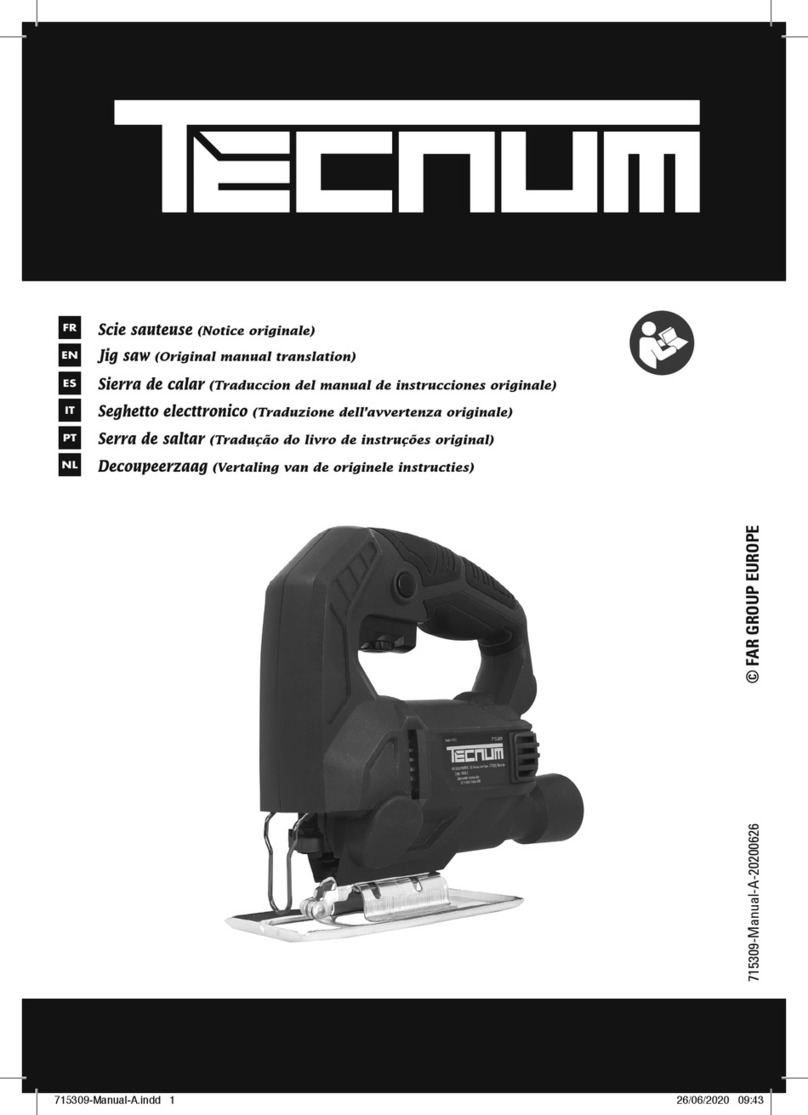
tecnum
tecnum TG55M5 Original manual translation

Parkside
Parkside PHKSA 12 B3 Translation of the original instructions
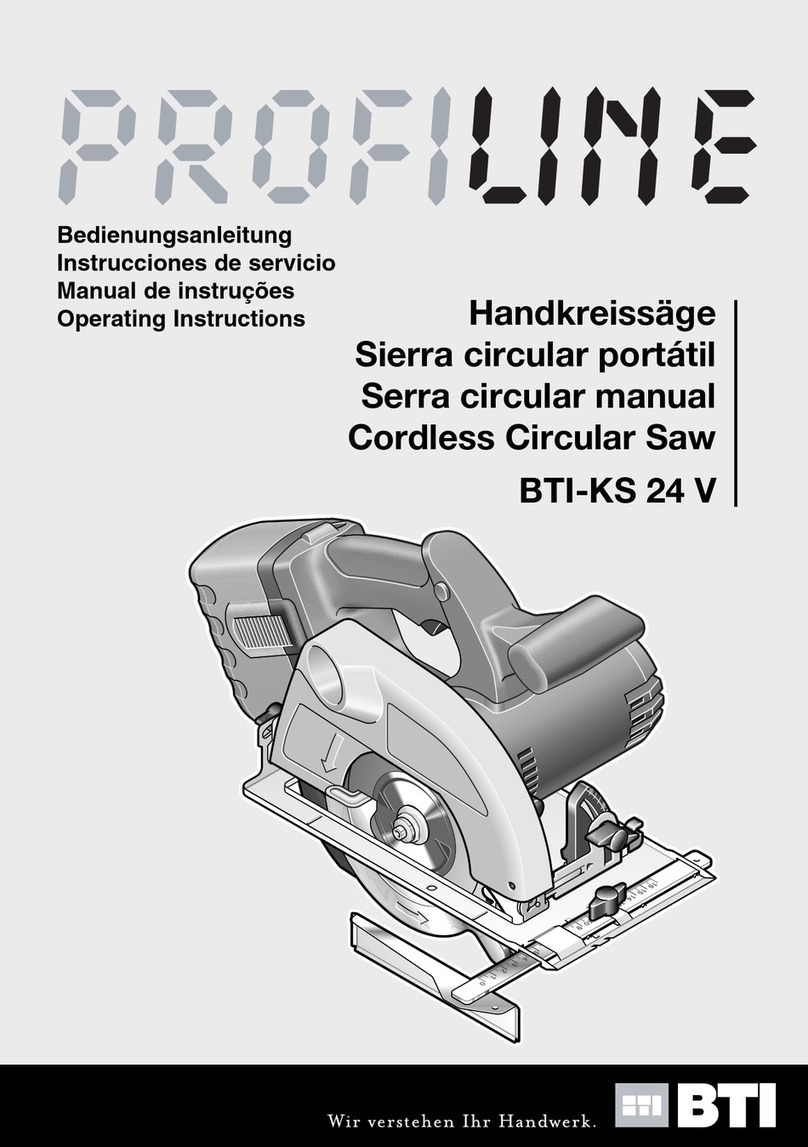
BTI
BTI Profiline BTI-KS 24 V operating instructions

Black & Decker
Black & Decker KS901 Original instructions
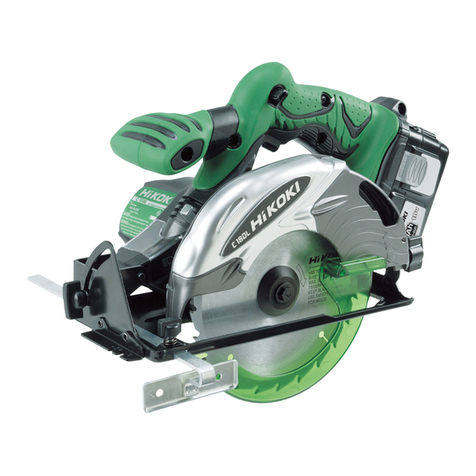
Hitachi
Hitachi C 18DL Technical data and service manual
